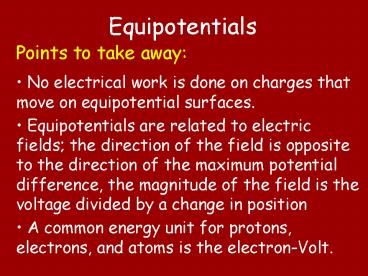Equipotentials - PowerPoint PPT Presentation
1 / 11
Title:
Equipotentials
Description:
Some examples putting equipotentials and fields together. ... capacitors. dielectrics. combinations of capacitors. DON'T FORGET TO DO YOUR PRE-CLASS QUIZ! ... – PowerPoint PPT presentation
Number of Views:111
Avg rating:3.0/5.0
Title: Equipotentials
1
Equipotentials
Points to take away
- No electrical work is done on charges that move
on equipotential surfaces. - Equipotentials are related to electric fields
the direction of the field is opposite to the
direction of the maximum potential difference,
the magnitude of the field is the voltage divided
by a change in position - A common energy unit for protons, electrons, and
atoms is the electron-Volt.
2
Equipotentials
- The name says it all equipotentials are sets of
points where the potentials are equal. - What does it mean when two locations have the
same potential? - The voltage between those points is zero,
- ?V W/q0 0
- No electric work is done on a charge that moves
along equipotentials.
3
Equipotentials
- But what are equipotentials?
- Like electric fields, they are just mathematical
constructs that often simplify the situation. - Unlike fields or forces, you only have one number
to worry about no directions!
4
Example
- What are the equipotentials for the parallel
plates below? - How much work is done on a positive test charge
that moves along path I? Path II?
-
II
I
5
Drawing Equipotentials
- When dealing with individual charges, we draw
equipotential surfaces that surround the charge. - This tree ring structure comes from the fact
that the potential values increase as we approach
the charge. - Think about looking down on the pointy end of a
cone. - If you cut it into slices, the highest slices
have the smallest radius.
6
Equipotentials Fields
- There is a very close connection between
equipotentials and field lines. - Equipotentials MUST be perpendicular to field
lines otherwise moving along an equipotential
would involve work. - Note that this doesnt tell us anything about the
magnitude of the field or its direction. - However, if we know the charges involved, it is
not difficult to find the direction.
7
Equipotentials Fields
- An indication of the magnitude of the field is
given by the spacing between equipotentials
close spacing large field, wide spacing
small field - Some examples putting equipotentials and fields
together. - I urge all of you to play with this simulation to
get a feel for both fields and equipotentials.
8
Equipotentials Fields
- Aside from drawing, we can also use
equipotentials to derive the magnitudes and
directions of constant electric fields
quantitatively. - Remember that we found the voltage of the
parallel plates to be,
?V W/q0 E d E ?x So, E ?V/?x
9
Equipotentials Fields
- How about the direction of the field?
- Which of the parallel plates has the higher
potential? - I can increase the potential of a test charge by
moving it towards the positive plate. - If I can only move a fixed distance which
direction do I have to go to get the maximum
potential increase? - The electric field points OPPOSITE to that
direction.
10
Whole Class Discussion
- You want to suspend an object in midair using
charged parallel plates. The object has a mass
of 1 g and a charge of 5 µC. - What configuration of parallel plates will you
need? Draw it. - What electric field magnitude will you need?
- Assuming the plates are 0.5 m apart, what is the
voltage between the plates? - Draw label some representative equipotentials.
11
Next
- Sections 16.3 16.5 Capacitance
- capacitors
- dielectrics
- combinations of capacitors
- DONT FORGET TO DO YOUR PRE-CLASS QUIZ!































